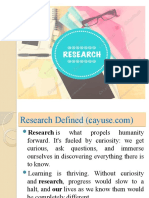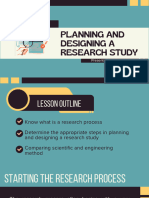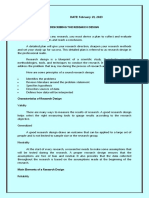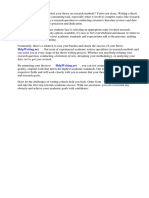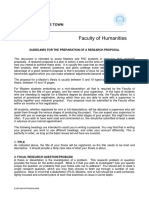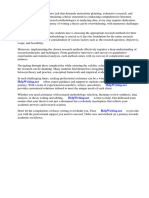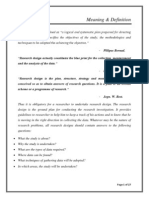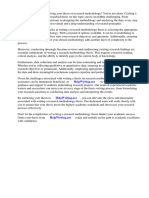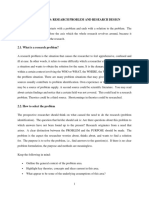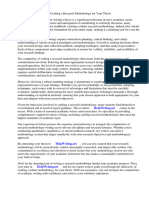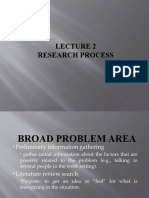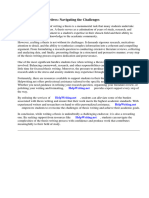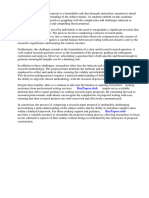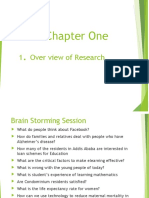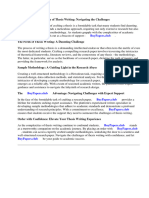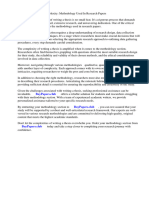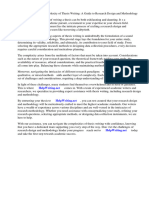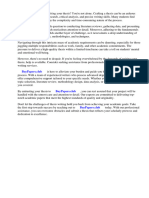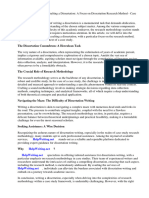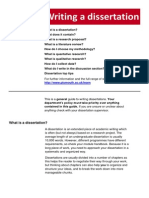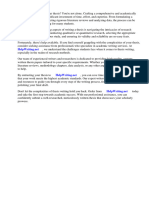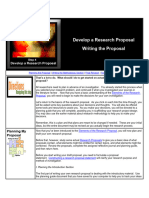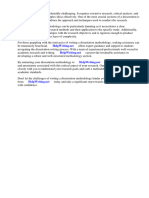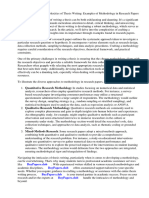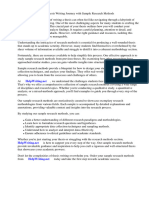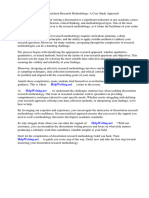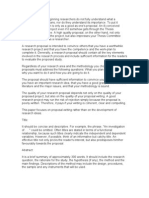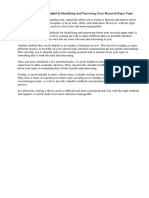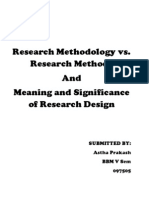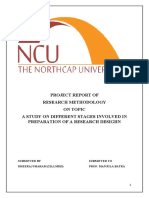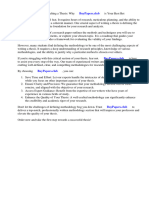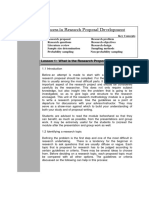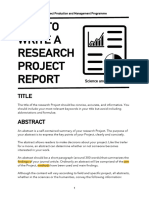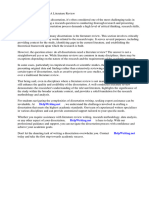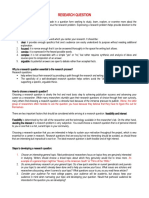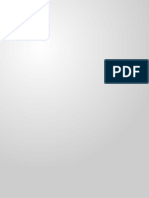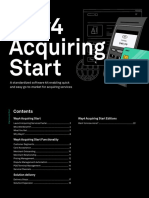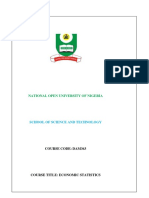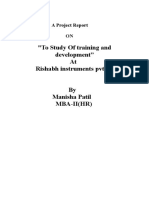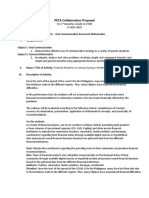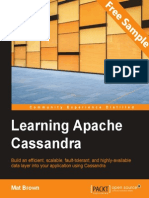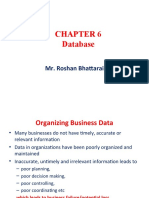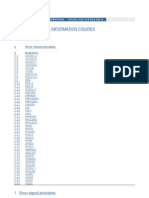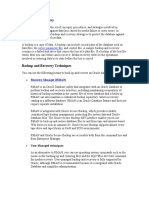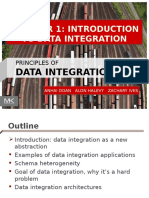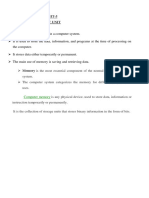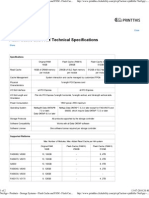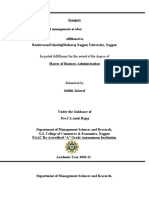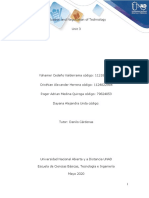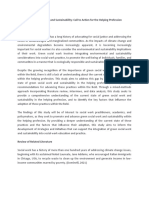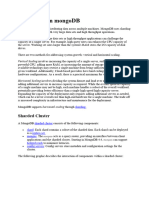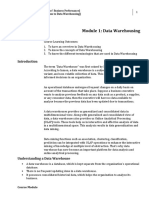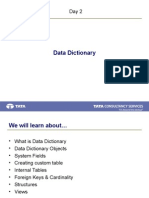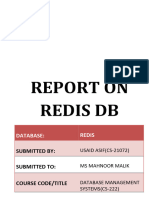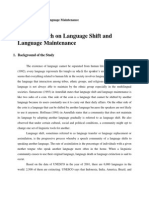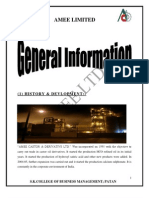Professional Documents
Culture Documents
2 Qualitative-Methods-In-Business-Research
2 Qualitative-Methods-In-Business-Research
Uploaded by
Apple PogoCopyright:
Available Formats
You might also like
- Research Presentation - Chapter 1Document17 pagesResearch Presentation - Chapter 1Rengeline LucasNo ratings yet
- Steps in Planning and Designing A Research Study Group 1 - 20231130 - 201939 - 0000Document47 pagesSteps in Planning and Designing A Research Study Group 1 - 20231130 - 201939 - 0000Patrish Jenine LaguaNo ratings yet
- Describing The Research DesignDocument15 pagesDescribing The Research DesignJao V. DuranNo ratings yet
- Research Methods Thesis TopicsDocument4 pagesResearch Methods Thesis TopicsPayToDoPaperSingapore100% (2)
- Research Prop Guide 2014Document4 pagesResearch Prop Guide 2014amani mahiNo ratings yet
- Dissertation Research Methods ChapterDocument8 pagesDissertation Research Methods ChapterBuyingPapersOnlineCollegeCanada100% (1)
- Methods of Research Thesis SampleDocument5 pagesMethods of Research Thesis Samplemichelledavisvirginiabeach100% (2)
- Media Research Unit 3Document22 pagesMedia Research Unit 3DragenvoygerNo ratings yet
- Research DesignDocument27 pagesResearch DesignMinaxi DakaNo ratings yet
- Research Methodology Thesis WritingDocument8 pagesResearch Methodology Thesis Writingrobinandersonwestvalleycity100% (2)
- Research Methodology Chapter 2Document7 pagesResearch Methodology Chapter 2jurasucceed30No ratings yet
- How To Write A Research Methodology For ThesisDocument4 pagesHow To Write A Research Methodology For Thesisgogelegepev2100% (2)
- Lecture 3-Research ProcessDocument22 pagesLecture 3-Research ProcessedwinyapsonNo ratings yet
- Thesis General ObjectivesDocument5 pagesThesis General ObjectivesWhereToBuyResumePaperLosAngeles100% (2)
- What Should Be Included in A Research Paper ProposalDocument5 pagesWhat Should Be Included in A Research Paper Proposaln0nijitynum3No ratings yet
- 1 IntroductionDocument33 pages1 Introductionabebe tizazuNo ratings yet
- Research Methodology An OverviewDocument49 pagesResearch Methodology An OverviewvijayakumaaranNo ratings yet
- Sample Methodology of Research PaperDocument8 pagesSample Methodology of Research Paperafmbemfec100% (1)
- Research Paper Methodology PartsDocument5 pagesResearch Paper Methodology Partsafmcdeafl100% (1)
- Examples of Research Methodology ThesisDocument4 pagesExamples of Research Methodology Thesisdnppn50e100% (2)
- Methodology Used in Research PapersDocument5 pagesMethodology Used in Research Papersc9spy2qz100% (1)
- Doing Research 2Document5 pagesDoing Research 2Anita Purnama SariNo ratings yet
- Develop A Research ProposalDocument11 pagesDevelop A Research ProposalMonic Romero100% (1)
- Rift Valley University: Course Title: Business Research MethodsDocument4 pagesRift Valley University: Course Title: Business Research MethodsAbdela Aman MtechNo ratings yet
- Sample Thesis Research Design and MethodologyDocument7 pagesSample Thesis Research Design and MethodologyAnita Miller100% (2)
- Methods of Research and Thesis Writing SampleDocument5 pagesMethods of Research and Thesis Writing SampleWhoWillWriteMyPaperForMeSingapore100% (2)
- Fundamentals of Research Methodology Term PaperDocument7 pagesFundamentals of Research Methodology Term Papergw0drhkfNo ratings yet
- Objectives of The Study Thesis ExampleDocument7 pagesObjectives of The Study Thesis ExampleWriteMyApaPaperCanada100% (2)
- How To Write A Research ProposalDocument4 pagesHow To Write A Research ProposalOmer UsmanNo ratings yet
- Dissertation Research Method Case StudyDocument6 pagesDissertation Research Method Case StudyCustomPaperWritingServicesUK100% (1)
- Writing A DissertationDocument8 pagesWriting A DissertationR.Gamage100% (1)
- Research Methods Thesis PDFDocument5 pagesResearch Methods Thesis PDFerintorresscottsdale100% (2)
- Thesis Main ObjectiveDocument6 pagesThesis Main Objectivelisaandersonshreveport100% (1)
- Develop A Research ProposalDocument11 pagesDevelop A Research ProposalJoychelle BaggayNo ratings yet
- PHD Thesis Proposal SampleDocument8 pagesPHD Thesis Proposal Samplesandyharwellevansville100% (2)
- Whether You Are A Student Whose Goal Is To Complete Course Requirements or A Researcher Looking For FundingDocument14 pagesWhether You Are A Student Whose Goal Is To Complete Course Requirements or A Researcher Looking For FundingRakeb AyalewNo ratings yet
- Dissertation Methodology Example PDFDocument5 pagesDissertation Methodology Example PDFBuyCollegePapersOnlineSingapore100% (1)
- DRM Lec01Document17 pagesDRM Lec01gelvanNo ratings yet
- Examples of Methodology in Research PaperDocument6 pagesExamples of Methodology in Research Papertrsrpyznd100% (1)
- Methodology Thesis Proposal ExampleDocument5 pagesMethodology Thesis Proposal Exampleafcmxfnqq100% (2)
- Sample Research Methods in ThesisDocument7 pagesSample Research Methods in Thesisaflodtsecumyed100% (1)
- What Is ResearchDocument2 pagesWhat Is ResearchVishwaraj NikumbhNo ratings yet
- Research: Proposal: Prof. Dr. Md. Ghulam Murtaza Khulna University Khulna, BangladeshDocument31 pagesResearch: Proposal: Prof. Dr. Md. Ghulam Murtaza Khulna University Khulna, BangladeshSaiful Hadi Mastor100% (1)
- Dissertation Research Methodology Case StudyDocument8 pagesDissertation Research Methodology Case StudyOnlinePaperWritingServicesSingapore100% (1)
- How To Write A Reseach PaperDocument5 pagesHow To Write A Reseach Papershahabjani9610No ratings yet
- Methods That May Be Helpful in Identifying and Narrowing Your Research Paper TopicDocument6 pagesMethods That May Be Helpful in Identifying and Narrowing Your Research Paper TopicafeascdczNo ratings yet
- Research Methodology vs. Research Methods and Meaning and Significance of Research DesignDocument5 pagesResearch Methodology vs. Research Methods and Meaning and Significance of Research DesignMahima SharanNo ratings yet
- Research MethodologyDocument15 pagesResearch MethodologyAvtar singhNo ratings yet
- Define Methodology in Research PaperDocument6 pagesDefine Methodology in Research Paperafmcbmoag100% (1)
- Undergraduate Dissertation Methodology ChapterDocument8 pagesUndergraduate Dissertation Methodology ChapterCollegePapersHelpUK100% (1)
- Research - ProposalDocument31 pagesResearch - ProposalEmmanuel Selase AsamoahNo ratings yet
- Research Methodology in A Research Paper ExamplesDocument6 pagesResearch Methodology in A Research Paper ExamplespqltbarifNo ratings yet
- PHD Course - VTeosa - Tema 9 - Research PlanningDocument18 pagesPHD Course - VTeosa - Tema 9 - Research PlanningAndrei GS ZapshaNo ratings yet
- ProposalDocument27 pagesProposalnaodbrtiNo ratings yet
- How To Write A Project ReportDocument11 pagesHow To Write A Project ReportFulyaNo ratings yet
- Do All Dissertations Need A Literature ReviewDocument5 pagesDo All Dissertations Need A Literature ReviewPayingSomeoneToWriteAPaperScottsdale100% (1)
- Writing Dissertation Methodology ExampleDocument5 pagesWriting Dissertation Methodology ExampleBuyAPaperOnlineBaltimore100% (1)
- Quantitative ResearchDocument6 pagesQuantitative ResearchJan Michael R. RemoladoNo ratings yet
- Academic Writing and Publishing with ChatGPT (Part-2): Dissertation and Thesis WritingFrom EverandAcademic Writing and Publishing with ChatGPT (Part-2): Dissertation and Thesis WritingNo ratings yet
- 18 Qualitative-Methods-In-Business-Research-8Document11 pages18 Qualitative-Methods-In-Business-Research-8Apple PogoNo ratings yet
- 5 Qualitative-Methods-In-Business-Research-2Document16 pages5 Qualitative-Methods-In-Business-Research-2Apple PogoNo ratings yet
- Way4 Acquiring Start: A Standardized Software Kit Enabling Quick and Easy Go-To-Market For Acquiring ServicesDocument23 pagesWay4 Acquiring Start: A Standardized Software Kit Enabling Quick and Easy Go-To-Market For Acquiring ServicesApple PogoNo ratings yet
- Digital Payments in Africa: Opportunities and Challenges 1Document20 pagesDigital Payments in Africa: Opportunities and Challenges 1Apple PogoNo ratings yet
- DAM 363 Economic StatisticsDocument223 pagesDAM 363 Economic StatisticsCollins MuseraNo ratings yet
- 3.1 JDBC PrinciplesDocument4 pages3.1 JDBC PrinciplesravicsNo ratings yet
- BDY4073 Lecture 3 Ethnobotanical Research - Methodology Part 1Document45 pagesBDY4073 Lecture 3 Ethnobotanical Research - Methodology Part 1Mei Jing WongNo ratings yet
- Training and DevelopmentDocument36 pagesTraining and DevelopmentManishaNo ratings yet
- Title Title Title Title: Author 1Document4 pagesTitle Title Title Title: Author 1Aprilia Puspita DewiNo ratings yet
- PETA - Gen Math & Oral Com1Document6 pagesPETA - Gen Math & Oral Com1Mark Jerald SolveroNo ratings yet
- 02 Modul Exasol SQL - enDocument41 pages02 Modul Exasol SQL - enPeterNo ratings yet
- Learning Apache Cassandra - Sample ChapterDocument20 pagesLearning Apache Cassandra - Sample ChapterPackt PublishingNo ratings yet
- Chapter 6 Introduction To DatabaseDocument33 pagesChapter 6 Introduction To DatabaseRishi Raj SharmaNo ratings yet
- Error Interrupt Information Figures: 1 Error Signal Principles 2 RegistersDocument23 pagesError Interrupt Information Figures: 1 Error Signal Principles 2 RegisterssaxgNo ratings yet
- Backup and RecoveryDocument6 pagesBackup and RecoveryFaizan RaoNo ratings yet
- Data IntegrationDocument38 pagesData IntegrationMohammad Afwan100% (1)
- Science Fair LetterDocument3 pagesScience Fair Letterapi-325015040No ratings yet
- History of AIDocument1 pageHistory of AISandro CafagnaNo ratings yet
- Data-Resource-managementDocument3 pagesData-Resource-managementMd. FaysalNo ratings yet
- Memory Unit - 5 Coa PDFDocument18 pagesMemory Unit - 5 Coa PDFArun KrishNo ratings yet
- Pam Vs Pam IIDocument2 pagesPam Vs Pam IIManish ChawlaNo ratings yet
- In Partial Fulfillment For The Award of The Degree Of: Submitted byDocument9 pagesIn Partial Fulfillment For The Award of The Degree Of: Submitted bySiddhi JaiswalNo ratings yet
- Linux Filesystem Features: Evolution of A de Facto Standard File System For Linux: Ext2'Document20 pagesLinux Filesystem Features: Evolution of A de Facto Standard File System For Linux: Ext2'Upendra KumarNo ratings yet
- Topic 1: Introduction To Data Mining: Instructor: Chris VolinskyDocument59 pagesTopic 1: Introduction To Data Mining: Instructor: Chris VolinskySalomNo ratings yet
- VNT - Step 3 - Group NumberDocument17 pagesVNT - Step 3 - Group Numberisaac contrerasNo ratings yet
- Green Social Work and SustainabilityDocument12 pagesGreen Social Work and SustainabilityRicardo TabladaNo ratings yet
- GraphQL+and+Android+Course+ +presentationDocument20 pagesGraphQL+and+Android+Course+ +presentationRahan SharmaNo ratings yet
- Sharding in MongoDBDocument3 pagesSharding in MongoDBVarun VaishnavNo ratings yet
- Eval of Business Performance - Module 1Document8 pagesEval of Business Performance - Module 1Daniela SamiaNo ratings yet
- ABAP - Data DictionaryDocument30 pagesABAP - Data DictionarysatishputranNo ratings yet
- Research: Amulung National High School 1Document28 pagesResearch: Amulung National High School 1Ann Catherine EcitaNo ratings yet
- RedisDocument8 pagesRedisusaida863No ratings yet
- Language Shift and Language MaintenanceDocument9 pagesLanguage Shift and Language MaintenanceNasrum MarjuniNo ratings yet
- Amee Limited: (1) History & DevlopmentDocument39 pagesAmee Limited: (1) History & DevlopmentjagtiNo ratings yet
2 Qualitative-Methods-In-Business-Research
2 Qualitative-Methods-In-Business-Research
Uploaded by
Apple PogoOriginal Title
Copyright
Available Formats
Share this document
Did you find this document useful?
Is this content inappropriate?
Report this DocumentCopyright:
Available Formats
2 Qualitative-Methods-In-Business-Research
2 Qualitative-Methods-In-Business-Research
Uploaded by
Apple PogoCopyright:
Available Formats
Research Design and Process
In: Qualitative Methods in Business Research
By: Päivi Eriksson & Anne Kovalainen
Pub. Date: 2011
Access Date: August 21, 2020
Publishing Company: SAGE Publications Ltd
City: London
Print ISBN: 9781412903172
Online ISBN: 9780857028044
DOI: https://dx.doi.org/10.4135/9780857028044
Print pages: 25-36
© 2008 SAGE Publications Ltd All Rights Reserved.
This PDF has been generated from SAGE Research Methods. Please note that the pagination of the
online version will vary from the pagination of the print book.
SAGE SAGE Research Methods
2008 SAGE Publications, Ltd. All Rights Reserved.
Research Design and Process
This chapter will give you information on:
?
why research planning is so important;
?
what elements are needed in research design;
?
how to select the research topic, research question(s) and how to get started;
?
the role of theories and philosophies in your research project;
?
what linearity and circularity mean in the research process;
?
how to think of time for the qualitative research process.
Importance of planning
When planning your research project, you often start with the idea of the research topic that you have
become interested in. Finding your research topic is important, but equally important is to sketch out the
whole research design, which consists of the planning of your whole research project. You will need to think
in several dimensions in relation to the research process before starting the actual research.
Research planning includes the selection of topic for your research and drafting of the work plan; that is, ‘how
to do things and in what order‘. Research design also includes the basic ideas and the viewpoints, for the
theoretical framework of your project, the rough time plan for the whole project and for the different parts of
it, the modes of data collection you might have available, and method choices you have available, given the
research question(s), framework and the data you plan to collect. According to Yin (2002), you need to think
logically through your rough research idea, outline the plan and think about the structure of inquiry for fulfilling
that plan. When writing the research design, you are already getting started with the research and developing
your rough research idea further (Silverman, 2005). A research plan helps you to think ahead, even if the
actual research would not always follow the plan originally sketched.
Research Design and Process
Page 2 of 13
SAGE SAGE Research Methods
2008 SAGE Publications, Ltd. All Rights Reserved.
It is rather usual to mix the idea of research design and research method with each other: the simplistic
division between qualitative and quantitative research that is sometimes presented as a decisive division
between research types is perhaps to blame for that confusion. Many research methods texts present case
studies, for example, only in relation to participant observation, and questionnaires only in relation to
comparative cross-sectional surveys, even if different methods of data collection can be used variably with
different types of research design.
What, then, does research design mean? De Vaus (2001: 16) states that research design refers to the
structure of an enquiry. We need to identify the possible types of data and evidence needed for answering our
research question(s) convincingly. This means that we do not collect data or use theories that only support
our views and are in favour of our beliefs, but open up the possibility for various alternative ways of answering
our research question as well. In practice, this means that different data collection types and methods can be
applied in a variety of research design types, even if you should be aware that some methods are more used,
or subscribe more closely to specific types of design. Therefore, you should not decide the method you aim
to use in your study before you have developed your rough research idea further.
Elements of the research design
Qualitative research does not usually follow a tightly woven plan. Owing to their philosophical and
methodological commitments, most qualitative research designs allow for deviations and surprises during
the research process in the data collection and analysis, and changes in the research settings during the
process. Even if the research design were not to be followed in the actual process of research, it is helpful
for the process to recognize some key elements that should be planned beforehand. These elements of
research design you also need when you write your research proposal for your supervisor or for your sponsor
or funding body of your research.
Choosing your research area and identifying the research topic
The key guiding principle for you here should be ‘researchability‘, i.e. whether the idea you have for research
is suitable and researchable or not. Often, the good test for researchability is to think whether the research
topic can be studied empirically or not (de Vaus, 2001; Flick, 2002), even if not all research questions are
empirical by nature. You may also be given a topic to research from your supervisor, but most often you
should decide on the topic yourself. Sometimes, equally good criteria for choosing a topic is to think in terms
of your own interests and priorities: you should have a genuine interest in the topic. A short literature review
on any topic will also reveal to you something about the researchable nature of that topic: Is there already a
vast amount of recent literature? Are there good journal articles available? Is the topic virtually unknown for
research? The research topic is the broad subject matter area that you are interested in; research question(s)
define more precisely the issues you wish to explore in your project.
Research Design and Process
Page 3 of 13
SAGE SAGE Research Methods
2008 SAGE Publications, Ltd. All Rights Reserved.
Formulating the research question(s)
After the topic selection, you may already have some ideas of the possible research questions in mind. Start
with the purpose of the study; it does not have to be precise, but it is crucial to think through what kind of
research you are doing. Why do you want to carry out the research? What is the purpose of your research
and why is it worth doing? How will you explore the matters of your interest?
You can write down your ideas and then think through them: What type of research question(s) are you
putting forward? You need to ask yourself, ‘What type of question do I aim to answer in my research?‘. Is
it a descriptive research question or an explanatory research question? The descriptive type of research
question is suited to e.g. descriptive research designs, whereas the explanatory question type usually
explores causes and/or consequences (e.g. of the type ‘effects of mergers on income levels of middle
management in banking‘). Does the question you have in mind call for a longitudinal design, such as exploring
or describing change or process over time (e.g. of the type ‘change in organizational culture after mergers
and acquisitions‘)? Or is it about a cross-sectional design that calls for descriptive analysis, such as in market
research of ‘what types of people consume genetically modified food‘?
It is important to keep in mind that the research problems and research questions drive your whole research
project, and the choice of methods and theoretical frame. Initially, with a rough research idea or research
topic, you start to reorganize your research topic into researchable question(s), and through literature reading
you might refine and frame the original idea into more precise research question(s). This process is often
iterative by nature.
Choice of appropriate method/methods
The research method you choose should be appropriately relevant for answering the research question(s)
you have formulated earlier. It is thus the research question that ‘dictates’ the choice of methods and the
type of research setting, and not the other way round. In each chapter of this book you will find examples
and arguments for each method. The guiding principle in choosing the method is the research question and
its focus, but methods are also closely attached to different theories and theoretical ideas about research;
therefore, weighing alternative methods in your research project can become important and should be related
to the theoretical aspects of your research project.
Throughout this book, when reading different methods chapters, you will notice that methods are not
developed or used in a vacuum in qualitative research. All research methods are loosely or closely interwoven
into theoretical underpinnings of methodologies such as epistemological and ontological assumptions,
which were discussed in Chapter 2. No method is thus a separate or mechanically added entity in a research
project, but it should be closely related to the researched question, data acquired and theoretical frame used
in the project.
Research Design and Process
Page 4 of 13
SAGE SAGE Research Methods
2008 SAGE Publications, Ltd. All Rights Reserved.
There are big differences between the various approaches in qualitative methodology, and the various
approaches differ from each other in the way the relationship between the qualitative data, method,
methodology and relation to theory in qualitative research is designed, and in the relational emphasis of these
elements. The differences in the ways the relationship between data, method and theory are understood in
the research show the vast variety of ways for doing qualitative analysis and research, and this is also visible
within business research. These differences stem from epistemological differences between the various
approaches which explain the differing emphases given in research. Epistemic differences are not always
visible in research settings; therefore, they cannot be directly addressed either.
In research settings, it is seldom sufficient to inform the reader that you are conducting qualitative research;
it is more important to tell them about what kind of qualitative research you are doing. The importance of
relating the details, materials, methodical tools and the ways you intend to use them gets more emphasis the
more informed you become with the qualitative research methods. This is especially true with rather ‘rigid’
and rule-driven method approaches, such as the grounded theory approach, but is even more important in
other approaches, where the rules regarding the knowing and knowledge production are not so clear.
Choice and role of appropriate theories
The correct choice of appropriate methods for research is crucial, as is the choice of the appropriate theories.
How, then, to be sure of the suitability of the choices? First of all, you need to think through your research
question: Is it researchable empirically? Is it possible to obtain empirical data for solving your research
question? Is it too wide or too narrow? These questions you need to think and rethink throughout your
research process, as you might need to reformulate, change wording in the question, etc. Therefore, it is
good to start writing down the possible theoretical linkages that might help you in finding the answers for your
research question(s).
Second, you need to think your research question in terms of methods: your research interest and research
question(s) should be determining factors for choosing a method, not the other way round. Sometimes,
students choose a qualitative method research project for the wrong reasons. The research question they put
forward calls for a quantitative research design. One example of such a research interest area and formulation
of a research question that would call for, for example, a cross-sectional large survey research in several
countries is of the type ‘The prevalence of business start-ups in the service sector middle management in
UK, Finland and Germany‘. Cross-sectional research design is possible in qualitative research, e.g. through
qualitative interviews of focus group analysis (e.g. Scase and Goffee, 1989), but for this example you
might need to rephrase the research topic, such as: ‘starting your own business as a service-sector middle
manager‘. You would be able to do comparative studies and compare cases from three different countries,
but would need to think hard why the country comparisons would be needed and in what ways you would
take the country dimension into account in your research.
The role of theories in qualitative research is not one-dimensional or as predictable as in logico-hypothetical
Research Design and Process
Page 5 of 13
SAGE SAGE Research Methods
2008 SAGE Publications, Ltd. All Rights Reserved.
research, where theories are used for the purpose of hypothesis testing. The choice and use of theories
in your work should be guided through your research purpose and research questions. The philosophical
underpinnings of your research approach, as discussed in the Chapter 2, might also have relevance for the
theories you choose for your research and the ways you will use them. It is important to remember also that
not all theories and approaches in the field of business research are compatible with the basic assumptions
and tenets of every different epistemological approach.
Later on in this chapter you will learn about the circularity of the research process, where the role and place for
theory in the research process emerges several times during the research process: you begin with research
idea or topic, review the theoretical literature and gather theoretical concepts that might be relevant in finding
the answer, then you reconsider and redefine your idea, revisit your research design and re-examine your
theoretical ideas, revisit the literature, and perhaps even redefine your research question(s) in accordance
with your research idea. The circularity, or deepening spiral nature, of the qualitative research project is quite
clear from this description: you can start with a rough idea, develop it through literature consultation and turn
it into a researchable question which can shift and change during the research process.
Design of data collection
Research data can consist of a variety of empirical data, and research design also means designing the
gathering of that data: what types of data, in what ways to gather, how to gain access, how to document, how
to plan the analysis, etc. Questions you need to think through concern the recording of data and in which
situations to record; will you be using research diary throughout the entire research project or only during data
collection? will you make field notes or will you rely on your recorded, transcribed materials? etc. Design of
data collection can also cover a variety of different designs, depending on the different data sets and materials
you might be using in your research project.
As we mentioned in Chapter 1, the complexities involved in method selection and the vast amount of
philosophical thinking that lies behind the methods lead us to a situation where we usually see methods at the
same time as both practical tools for the analysis of the empirical data and as frameworks for engaging with
empirical analysis of data. This way of seeing methods is typical for qualitative approaches in social sciences
and in business research. Even if we can disseminate the data gathering and data analysing processes from
each other, they very often are closely related and interwoven with each other.
Qualitative research does not rely on unified theoretical and methodological concepts: a variety of different
theories, methods and methodological thinking are possible in qualitative research, as you will notice when
reading through the methods chapters in this book. However, there are some elements that are common to
all qualitative research. One unifying element in the research process is the reflexivity: you should take your
part in knowledge production as an important one, and not exclude it from the research process or reporting.
This means in practice that researchers are integrally part of research process, not excluded from it as in
logico-deductive analysis. The subjectivities of the researcher and of those who are studied are part of the
Research Design and Process
Page 6 of 13
SAGE SAGE Research Methods
2008 SAGE Publications, Ltd. All Rights Reserved.
interpretation, and documented in research diaries and protocols (e.g. Flick, 2002; Creswell, 2003; Silverman,
2005).
You may also need to think about your research topic in terms of originality. Will it be the topic of your research
that is original, or will it be carrying out empirical work that has not been done before, or will it be looking
at areas that have not been looked at in your discipline before? There are multiple ways of being original:
through ideas, data, methods, interpretations, or knowledge produced. You may also need to think of the
different audiences for your research project, as they have their own conventions and styles (Box 3.1). We
will discuss the different audiences and writing styles in more detail in Chapter 18.
For most qualitative research projects in business studies, it is organizations, companies and corporations
that are the sources and sites for research questions and for empirical data. It is far more crucial for qualitative
research to negotiate and gain access to the field than it is in a quantitative research project. Participant
observations, open interviews, focus groups and case studies require methodically either close or
Box 3.1 Procedure for research process
Steps to be taken in the research process after the initial project formulation:
entry negotiations to data resources;
entering the field and collecting data;
analysis and interpretation of data;
writing up the empirical results;
writing up the literature review.
intense contact, or acquired access to the organization, institution, company or group in question. Securing
collaboration and informed consent to participate in the research project is one of the challenges that the
qualitative researcher faces when gathering data. Access to institutions such as companies can be highly
problematic, as (from the company's point of view) the research consumes employees’ time and can even
pose safety problems in many ways, ranging from industrial health-and-safety regulations (case studies at
industrial plants) to fears of industrial espionage and leaks of information. These questions will be discussed
in detail further in Chapter 6 on research ethics.
The plan for analysing and interpreting the research materials needs to go hand in hand with the method
choices you will make and the research design of your study in general. Forthcoming chapters in this book
will discuss in detail in what ways to analyse materials and the appropriateness of the different methods. The
form and design of any gathering of research materials needs to be cross-checked with the method and with
the theoretical background of your study (Flick, 2002). Chapter 18 will deal specifically with the general and
specific issues of writing up qualitative research, and here we only take up the interrelatedness of writing up
Research Design and Process
Page 7 of 13
SAGE SAGE Research Methods
2008 SAGE Publications, Ltd. All Rights Reserved.
the empirical results and theoretical views. You should not think of them as two separate issues and fields,
but see the qualitative research process (different parts of research design) as one interrelated process.
Circularity of research process
As mentioned earlier, in practice the research process is rarely clear cut, straightforward and linear. This is
what makes research so exciting; you learn new things along the way. From the moment you start thinking
about your research project, it is rare that you would be able to develop it into a straightforward research
report directly, without correcting, revising or changing parts of the work, even changing your originally chosen
methods, and finally, revising and correcting the original research question(s) and formulations, when writing
up the final version of your project. The possibility for revisiting of research plan and reformulating the
research design is one of the strengths of qualitative research.
Instead of a linear model of research, a more realistic picture of the research process is that of a circular
process, where it is almost necessary to move back and forth during the different phases in the research
process. The research process has many elements and tenets, as introduced earlier, ranging from formulating
the research field, focusing on interesting themes or ideas, gradually defining the research problem, finding
the right and precise enough expression for the research question(s), to empirical data collection, after the
entrance to the field, method selection, analysis, writing up the results and literature review so that writing up
the research report, be it then a Master's or PhD thesis, shows your work, knowledge and skills.
Traditionally, and even today, students learn about research, planning and fulfilling it as if a research project
were a linear process. This way of thinking about research relies heavily on the hypotheticdeductive idea of
doing research. According to the hypotheticdeductive model, the researcher starts the research by building
up a theoretical model based on the literature, previous studies on the subject and theoretical reading, where
several relationships, relations and conditions might exist in the data. This modelling is based on earlier
research and theoretical literature alone. The modelling usually leads to hypothesis setting, which is then
operationalized and tested against empirical data gathered for the purpose through surveys or, for example,
statistics. The empirical data are analysed and looked at through modelling developed earlier in the research
process, and often with the help of hypotheses, where variable relations, causalities and effects are important.
After the analysis, the research report writing process is relatively straightforward, even if small corrections in
the model usually result from the analysis of empirical materials. Causes and effects, and simple or complex
causal propositions, are usually the ways to analyse the data, especially when explanatory research design
is in question (de Vaus, 2001). After the survey questionnaire is designed and completed, the corrective
measures are not usually easy to make, and the iterative nature of the research process is missing.
Qualitative research matches with the traditional linear logic of research as described above only partially
and most often poorly. Qualitative research settings do not operate on preset modelling on variables and their
mutual correlational or causal relationships, but more on constant circularity and linking empirical analysis to
a flexible literature review and theories. The relevance of empirical material to researched questions, rather
Research Design and Process
Page 8 of 13
SAGE SAGE Research Methods
2008 SAGE Publications, Ltd. All Rights Reserved.
than the existence of relationships in the earlier literature, is crucial. The way the researcher in qualitative
research works their way through the empirical material is not based on preset existing connections between
variables, but by taking into account not only the focus of the study, but also the context of the study. This
inevitably increases the complexity of the study.
Part of the circularity of the research process is the previously mentioned process of reflexivity: owing to
circularity of the research process, the researcher in qualitative research is compelled to reflect the research
process as a whole and relate each step to previous ones, as they are not predetermined as in a linear
research model. More specifically, reflexivity is especially related to the ways of doing fieldwork: researchers
reflects their own biases, prejudices and position in relation to the researched object. More generally,
reflexivity relates to interpretations made during the research process, positions taken, etc. Reflexivity is a
means for critically inspecting the whole of the research process; and understood in this way, reflexivity is an
important procedure for establishing the validity of accounts of the phenomena studied (Schwandt, 2001).
The different tenets in the issue of validity will be discussed in more detail in Chapter 19.
The circularity of the research process can also be related to the so-called hermeneutic circle. The
hermeneutic circle refers to the methodological process of understanding, constructing and deepening a
meaning in the interpretative process during research activities. The prior knowledge is interpreted by the
researcher and in that process the tradition (prior knowledge) can be modified and changed. The hermeneutic
circle (originally by Schleiermacher, 17681834, and later developed in the works of Heidegger and Husserl)
is close to the German verstehende sociology, where the centrality of the language and meaning became
important. In hermeneutics, objects are not fixed or given; rather, they are interpreted, contingent things.
The process of interpretation involves an entering into the hermeneutic circle. The hermeneutic circle is thus
not strictly taken as a method for uncovering meaning, but a way of conceptualizing understanding and
the process of interpretation to which we as researchers participate and where we are situated. When we
interpret, it is not without our own gender, experiences, culture and expectations. We interpret things, not in
vacuum, but in a hermeneutic process. For more, see for example Habermas (1988) and Giddens (1993).
If the linear research model is abandoned in the qualitative research process, for the most part, does this then
mean that the researcher can start with research and data gathering without any prior knowledge or literature
review? The roles of and positions given to literature and theory are not so determined in qualitative research
as they are in logico-deductive mode: prior knowledge is also needed in qualitative research, but the prior
knowledge could be regarded as ‘preliminary versions of understanding of and the perspective on the object
being studied’ (Flick, 2002: 43). These preliminary versions of knowledge then become further elaborated
during the research process, through learning, analysing and reading of materials. This is the hermeneutic
circle mentioned earlier: as the researcher's knowledge base grows and changes, so also, therefore, does
their position towards prior knowledge change. The processual working towards meaningful interpretation
and answering to the research question allows for corrective measures to be taken into account during the
research process as iterative processes.
Research Design and Process
Page 9 of 13
SAGE SAGE Research Methods
2008 SAGE Publications, Ltd. All Rights Reserved.
Time and qualitative research process
All research projects have a specific time span and limitations in terms of the maximum number of months
or years they can take. All research projects have their start and their end. Therefore, it is important to learn
to plan your project effectively in terms of the time that the different research phases require (Box 3.2). The
research design and research plan also give you indications of the time-frame needed for different activities:
the time plan should be an integral part of your research design. Try to be realistic from the day you start
planning your project. What type of research project are you aiming for? Getting access to texts in the libraries
is much less time consuming than trying to get access to executive CEOs of large companies and reserving
interview time with them. Analysis of complex data, such as video and audio tapes of focus groups, needs
more time allocated
Box 3.2 Time use in the research project
The time plan for the research project should include the following elements:
?Time for reading theories, research reports, and articles prior to gathering
materials, in order to learn to know the field and find the focus for the research
project. This reading time is needed throughout your research project on several
occasions, not just at the beginning. Time for research design, learning to
develop, see new details as part of the whole, and think through the various
detailed aspects and parts of your research project. This design time is also
something that you need to reserve throughout your project in order to fit bits
and pieces together.
?Time for data gathering. This part could consist of, among others, the planning
phase, access-negotiation phase, data-gathering phase, etc. This data-
gathering time needs to cover all the time you need from initial contacts with
your target organization, to gathering, sorting out, filling in, and adding new
materials into your data; Time for the data analysis. Before the analysis, you
need to have a plan for the analysis that should be in relation to your research
question(s). Do not underestimate the time required by the analysis phase.
Sometimes, students think that the analysis and writing can go rather smoothly
hand in hand, and even take place simultaneously, and the final version of the
thesis is done while analysing the materials. Most often this is not the case, so
do reserve enough time for the analysis phase.
Research Design and Process
Page 10 of 13
SAGE SAGE Research Methods
2008 SAGE Publications, Ltd. All Rights Reserved.
?Time for writing up your report. Most often, with good planning and design,
the writing process goes smoothly, even if you need to find your own style.
Sometimes, though, you might find it necessary to turn the design of the whole
work upside down, to make your argument(s) work better in the report. Thinking
through the structure of the thesis and the way to report your findings and
results takes time and is an iterative process throughout the research project.
We will discuss the writing process in more detail in Chapter 18.
?Time for dissemination/defence/inspection/re-entering the field. Depending on
your project, you might need to reserve time for your viva defence, or inspection
of your work, for the media when reporting your results, or to the community
from where you have gathered your research materials. All these different
activities are surprisingly time consuming.
for transcriptions, coding and analysing than do structured interview data with individuals.
You should start your research project by planning a preliminary timetable and discussing it with your
supervisor. It is important that both of you have a similar kind of time-frame in mind for your research.
Remember that time schedules also need revisions during the research process. It is part of research design.
When you will face delays in your data gathering or reporting, do let your supervisor know about the delay
and the reasons for it in time.
The scope and size of your research project inevitably has an effect on the time your project will need. Here,
you need to think once again about the time and resources available and whether you can you manage
your research project. You might need to discuss with your supervisor about the time span: How much time
do you have available for your project? What happens if you face delays in the data gathering or analysis
phase? Depending on time, you might need to limit the extent of data collection or find alternative solutions.
Therefore, research design is important, as you can already think through the possible alternative routes to
your destination beforehand. Very often the time is also money, and the costs of research create alternative
costs: you might need to postpone participation with other courses due to exceeding your time-frame with
your research project, etc. Therefore, limitations on your time-frame underline the importance of planning
the time-frame ahead and scheduling different activities in your research project on paper in your research
design.
Key points of the chapter
Research Design and Process
Page 11 of 13
SAGE SAGE Research Methods
2008 SAGE Publications, Ltd. All Rights Reserved.
Research design is not just research plan of the empirical part of the study;
rather, it consists of multilayered decisions and issues. Research design covers
all issues from theoretical reading, the methodological choices, to the empirical
data gathering, analysis and writing processes. It is useful to plan your research
project properly, as it gets easier for you to see details and their relation to the
whole project.
The research process progresses most often through a circular process, not
according to a linear model. Revising and revisiting your original ideas and
thoughts, revisiting your plan and reading lists, and rewriting your chapters is an
essential part of this circularity.
Time use is most often the most important frame for your project: all projects
have a start and an end. Plan the different phases of your project realistically
from the very beginning. Find out about the time that the different data-gathering
processes demand and plan your work time accordingly.
Further reading
The book by Silverman (2005), Doing Qualitative Research, takes you through the different stages in the
research process hand in hand with lots of examples from a UK context.
Brewerton and Millward's (2001) Organizational Research Methods helps you in planning the research
process in any organizational and business research setting.
Exercise 1 Finding a research question with research design
Come up with a research topic that is close to your own research interests or disciplinary
field that you are interested in. The research topic can also relate to an actual
phenomenon in businesses or organizations. Write down as many different research
questions that you can think of from that one research topic in a short time. What kinds of
research designs would these different research questions require?
Alternatively, you can do this exercise with your research fellow or colleague: come up with
one joint research topic and then separately write down as many research questions as
you can and develop a research design for them. Discuss your results and find out how
Research Design and Process
Page 12 of 13
SAGE SAGE Research Methods
2008 SAGE Publications, Ltd. All Rights Reserved.
many similarities and differences you come up with in your responses. The collective form
of this exercise gives you an idea of how many different kinds of research questions can
be found, and how differently they can be designed into a research plan.
http://dx.doi.org/10.4135/9780857028044.d16
Research Design and Process
Page 13 of 13
You might also like
- Research Presentation - Chapter 1Document17 pagesResearch Presentation - Chapter 1Rengeline LucasNo ratings yet
- Steps in Planning and Designing A Research Study Group 1 - 20231130 - 201939 - 0000Document47 pagesSteps in Planning and Designing A Research Study Group 1 - 20231130 - 201939 - 0000Patrish Jenine LaguaNo ratings yet
- Describing The Research DesignDocument15 pagesDescribing The Research DesignJao V. DuranNo ratings yet
- Research Methods Thesis TopicsDocument4 pagesResearch Methods Thesis TopicsPayToDoPaperSingapore100% (2)
- Research Prop Guide 2014Document4 pagesResearch Prop Guide 2014amani mahiNo ratings yet
- Dissertation Research Methods ChapterDocument8 pagesDissertation Research Methods ChapterBuyingPapersOnlineCollegeCanada100% (1)
- Methods of Research Thesis SampleDocument5 pagesMethods of Research Thesis Samplemichelledavisvirginiabeach100% (2)
- Media Research Unit 3Document22 pagesMedia Research Unit 3DragenvoygerNo ratings yet
- Research DesignDocument27 pagesResearch DesignMinaxi DakaNo ratings yet
- Research Methodology Thesis WritingDocument8 pagesResearch Methodology Thesis Writingrobinandersonwestvalleycity100% (2)
- Research Methodology Chapter 2Document7 pagesResearch Methodology Chapter 2jurasucceed30No ratings yet
- How To Write A Research Methodology For ThesisDocument4 pagesHow To Write A Research Methodology For Thesisgogelegepev2100% (2)
- Lecture 3-Research ProcessDocument22 pagesLecture 3-Research ProcessedwinyapsonNo ratings yet
- Thesis General ObjectivesDocument5 pagesThesis General ObjectivesWhereToBuyResumePaperLosAngeles100% (2)
- What Should Be Included in A Research Paper ProposalDocument5 pagesWhat Should Be Included in A Research Paper Proposaln0nijitynum3No ratings yet
- 1 IntroductionDocument33 pages1 Introductionabebe tizazuNo ratings yet
- Research Methodology An OverviewDocument49 pagesResearch Methodology An OverviewvijayakumaaranNo ratings yet
- Sample Methodology of Research PaperDocument8 pagesSample Methodology of Research Paperafmbemfec100% (1)
- Research Paper Methodology PartsDocument5 pagesResearch Paper Methodology Partsafmcdeafl100% (1)
- Examples of Research Methodology ThesisDocument4 pagesExamples of Research Methodology Thesisdnppn50e100% (2)
- Methodology Used in Research PapersDocument5 pagesMethodology Used in Research Papersc9spy2qz100% (1)
- Doing Research 2Document5 pagesDoing Research 2Anita Purnama SariNo ratings yet
- Develop A Research ProposalDocument11 pagesDevelop A Research ProposalMonic Romero100% (1)
- Rift Valley University: Course Title: Business Research MethodsDocument4 pagesRift Valley University: Course Title: Business Research MethodsAbdela Aman MtechNo ratings yet
- Sample Thesis Research Design and MethodologyDocument7 pagesSample Thesis Research Design and MethodologyAnita Miller100% (2)
- Methods of Research and Thesis Writing SampleDocument5 pagesMethods of Research and Thesis Writing SampleWhoWillWriteMyPaperForMeSingapore100% (2)
- Fundamentals of Research Methodology Term PaperDocument7 pagesFundamentals of Research Methodology Term Papergw0drhkfNo ratings yet
- Objectives of The Study Thesis ExampleDocument7 pagesObjectives of The Study Thesis ExampleWriteMyApaPaperCanada100% (2)
- How To Write A Research ProposalDocument4 pagesHow To Write A Research ProposalOmer UsmanNo ratings yet
- Dissertation Research Method Case StudyDocument6 pagesDissertation Research Method Case StudyCustomPaperWritingServicesUK100% (1)
- Writing A DissertationDocument8 pagesWriting A DissertationR.Gamage100% (1)
- Research Methods Thesis PDFDocument5 pagesResearch Methods Thesis PDFerintorresscottsdale100% (2)
- Thesis Main ObjectiveDocument6 pagesThesis Main Objectivelisaandersonshreveport100% (1)
- Develop A Research ProposalDocument11 pagesDevelop A Research ProposalJoychelle BaggayNo ratings yet
- PHD Thesis Proposal SampleDocument8 pagesPHD Thesis Proposal Samplesandyharwellevansville100% (2)
- Whether You Are A Student Whose Goal Is To Complete Course Requirements or A Researcher Looking For FundingDocument14 pagesWhether You Are A Student Whose Goal Is To Complete Course Requirements or A Researcher Looking For FundingRakeb AyalewNo ratings yet
- Dissertation Methodology Example PDFDocument5 pagesDissertation Methodology Example PDFBuyCollegePapersOnlineSingapore100% (1)
- DRM Lec01Document17 pagesDRM Lec01gelvanNo ratings yet
- Examples of Methodology in Research PaperDocument6 pagesExamples of Methodology in Research Papertrsrpyznd100% (1)
- Methodology Thesis Proposal ExampleDocument5 pagesMethodology Thesis Proposal Exampleafcmxfnqq100% (2)
- Sample Research Methods in ThesisDocument7 pagesSample Research Methods in Thesisaflodtsecumyed100% (1)
- What Is ResearchDocument2 pagesWhat Is ResearchVishwaraj NikumbhNo ratings yet
- Research: Proposal: Prof. Dr. Md. Ghulam Murtaza Khulna University Khulna, BangladeshDocument31 pagesResearch: Proposal: Prof. Dr. Md. Ghulam Murtaza Khulna University Khulna, BangladeshSaiful Hadi Mastor100% (1)
- Dissertation Research Methodology Case StudyDocument8 pagesDissertation Research Methodology Case StudyOnlinePaperWritingServicesSingapore100% (1)
- How To Write A Reseach PaperDocument5 pagesHow To Write A Reseach Papershahabjani9610No ratings yet
- Methods That May Be Helpful in Identifying and Narrowing Your Research Paper TopicDocument6 pagesMethods That May Be Helpful in Identifying and Narrowing Your Research Paper TopicafeascdczNo ratings yet
- Research Methodology vs. Research Methods and Meaning and Significance of Research DesignDocument5 pagesResearch Methodology vs. Research Methods and Meaning and Significance of Research DesignMahima SharanNo ratings yet
- Research MethodologyDocument15 pagesResearch MethodologyAvtar singhNo ratings yet
- Define Methodology in Research PaperDocument6 pagesDefine Methodology in Research Paperafmcbmoag100% (1)
- Undergraduate Dissertation Methodology ChapterDocument8 pagesUndergraduate Dissertation Methodology ChapterCollegePapersHelpUK100% (1)
- Research - ProposalDocument31 pagesResearch - ProposalEmmanuel Selase AsamoahNo ratings yet
- Research Methodology in A Research Paper ExamplesDocument6 pagesResearch Methodology in A Research Paper ExamplespqltbarifNo ratings yet
- PHD Course - VTeosa - Tema 9 - Research PlanningDocument18 pagesPHD Course - VTeosa - Tema 9 - Research PlanningAndrei GS ZapshaNo ratings yet
- ProposalDocument27 pagesProposalnaodbrtiNo ratings yet
- How To Write A Project ReportDocument11 pagesHow To Write A Project ReportFulyaNo ratings yet
- Do All Dissertations Need A Literature ReviewDocument5 pagesDo All Dissertations Need A Literature ReviewPayingSomeoneToWriteAPaperScottsdale100% (1)
- Writing Dissertation Methodology ExampleDocument5 pagesWriting Dissertation Methodology ExampleBuyAPaperOnlineBaltimore100% (1)
- Quantitative ResearchDocument6 pagesQuantitative ResearchJan Michael R. RemoladoNo ratings yet
- Academic Writing and Publishing with ChatGPT (Part-2): Dissertation and Thesis WritingFrom EverandAcademic Writing and Publishing with ChatGPT (Part-2): Dissertation and Thesis WritingNo ratings yet
- 18 Qualitative-Methods-In-Business-Research-8Document11 pages18 Qualitative-Methods-In-Business-Research-8Apple PogoNo ratings yet
- 5 Qualitative-Methods-In-Business-Research-2Document16 pages5 Qualitative-Methods-In-Business-Research-2Apple PogoNo ratings yet
- Way4 Acquiring Start: A Standardized Software Kit Enabling Quick and Easy Go-To-Market For Acquiring ServicesDocument23 pagesWay4 Acquiring Start: A Standardized Software Kit Enabling Quick and Easy Go-To-Market For Acquiring ServicesApple PogoNo ratings yet
- Digital Payments in Africa: Opportunities and Challenges 1Document20 pagesDigital Payments in Africa: Opportunities and Challenges 1Apple PogoNo ratings yet
- DAM 363 Economic StatisticsDocument223 pagesDAM 363 Economic StatisticsCollins MuseraNo ratings yet
- 3.1 JDBC PrinciplesDocument4 pages3.1 JDBC PrinciplesravicsNo ratings yet
- BDY4073 Lecture 3 Ethnobotanical Research - Methodology Part 1Document45 pagesBDY4073 Lecture 3 Ethnobotanical Research - Methodology Part 1Mei Jing WongNo ratings yet
- Training and DevelopmentDocument36 pagesTraining and DevelopmentManishaNo ratings yet
- Title Title Title Title: Author 1Document4 pagesTitle Title Title Title: Author 1Aprilia Puspita DewiNo ratings yet
- PETA - Gen Math & Oral Com1Document6 pagesPETA - Gen Math & Oral Com1Mark Jerald SolveroNo ratings yet
- 02 Modul Exasol SQL - enDocument41 pages02 Modul Exasol SQL - enPeterNo ratings yet
- Learning Apache Cassandra - Sample ChapterDocument20 pagesLearning Apache Cassandra - Sample ChapterPackt PublishingNo ratings yet
- Chapter 6 Introduction To DatabaseDocument33 pagesChapter 6 Introduction To DatabaseRishi Raj SharmaNo ratings yet
- Error Interrupt Information Figures: 1 Error Signal Principles 2 RegistersDocument23 pagesError Interrupt Information Figures: 1 Error Signal Principles 2 RegisterssaxgNo ratings yet
- Backup and RecoveryDocument6 pagesBackup and RecoveryFaizan RaoNo ratings yet
- Data IntegrationDocument38 pagesData IntegrationMohammad Afwan100% (1)
- Science Fair LetterDocument3 pagesScience Fair Letterapi-325015040No ratings yet
- History of AIDocument1 pageHistory of AISandro CafagnaNo ratings yet
- Data-Resource-managementDocument3 pagesData-Resource-managementMd. FaysalNo ratings yet
- Memory Unit - 5 Coa PDFDocument18 pagesMemory Unit - 5 Coa PDFArun KrishNo ratings yet
- Pam Vs Pam IIDocument2 pagesPam Vs Pam IIManish ChawlaNo ratings yet
- In Partial Fulfillment For The Award of The Degree Of: Submitted byDocument9 pagesIn Partial Fulfillment For The Award of The Degree Of: Submitted bySiddhi JaiswalNo ratings yet
- Linux Filesystem Features: Evolution of A de Facto Standard File System For Linux: Ext2'Document20 pagesLinux Filesystem Features: Evolution of A de Facto Standard File System For Linux: Ext2'Upendra KumarNo ratings yet
- Topic 1: Introduction To Data Mining: Instructor: Chris VolinskyDocument59 pagesTopic 1: Introduction To Data Mining: Instructor: Chris VolinskySalomNo ratings yet
- VNT - Step 3 - Group NumberDocument17 pagesVNT - Step 3 - Group Numberisaac contrerasNo ratings yet
- Green Social Work and SustainabilityDocument12 pagesGreen Social Work and SustainabilityRicardo TabladaNo ratings yet
- GraphQL+and+Android+Course+ +presentationDocument20 pagesGraphQL+and+Android+Course+ +presentationRahan SharmaNo ratings yet
- Sharding in MongoDBDocument3 pagesSharding in MongoDBVarun VaishnavNo ratings yet
- Eval of Business Performance - Module 1Document8 pagesEval of Business Performance - Module 1Daniela SamiaNo ratings yet
- ABAP - Data DictionaryDocument30 pagesABAP - Data DictionarysatishputranNo ratings yet
- Research: Amulung National High School 1Document28 pagesResearch: Amulung National High School 1Ann Catherine EcitaNo ratings yet
- RedisDocument8 pagesRedisusaida863No ratings yet
- Language Shift and Language MaintenanceDocument9 pagesLanguage Shift and Language MaintenanceNasrum MarjuniNo ratings yet
- Amee Limited: (1) History & DevlopmentDocument39 pagesAmee Limited: (1) History & DevlopmentjagtiNo ratings yet
